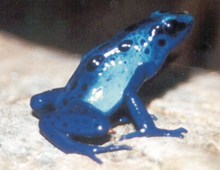Description: Blue poison dart frogs are bright blue, the limbs are royal blue and the belly is dark blue. There is an irregular pattern of small and large dark spots covering the head and back. The pattern of these spots is unique to each individual frog and can be used for identification, just like human fingerprints. Within the skin there are poisonous glands that secrete alkaloid poisons. These toxic poisons are used for defense and are capable of paralyzing or killing predators. Each foot has four toes equipped with a suction cup pad used for gripping; females flattened toe tips are round and males are heart-shaped.
Size: They are 1.2 to 1.8 inches (3-4.5 cm) in length and weigh about one ounce (3 gr). The females are larger than the males.
Behavior: These frogs are active during the day (diurnal) and remain close to water sources. This species is aggressive and very territorial. Both sexes will defend their territory from their own kind and others and females will ‘fight’ off other females during mating season.
Diet: It is the combination of what they eat that makes them poisonous. In the wild, their diet consists of ants, beetles, caterpillars, flies, maggots, mites, spiders and termites. They lose their toxic qualities in captivity because they are raised on fruit flies and crickets.
Senses: Blue poison dart frogs have excellent senses of sight and smell.
Communication: To deter intruders, these frogs use a series of calls. During mating season, males use soft calls to attract females.
Reproduction: Breeding usually takes place during the rainy season (February-March). Males establish a territory and emit quiet calls to attract a female. Several females usually respond to a male’s call and will fight aggressively until there is one winner. The victorious female begins the courtship ritual by nudging the male and stroking his snout and back with her front legs. The two will then go to a secluded spot near a water source to mate. The female lays a clutch size of two to six eggs. The eggs are kept moist until they hatch, 14-18 days later. The small tadpoles are carried to a small water pool such as in bromeliads to develop. They mature into adults in about 10 to 12 weeks.
Habitat/range: They are found on the” forest-islands”, arising out of the Sipaliwini savannah of Suriname and Brazil where there is high humidity and moderate to cooler temperatures.
Status: IUCN – Least Concern; CITES Appendix II.



